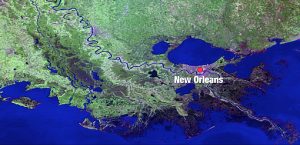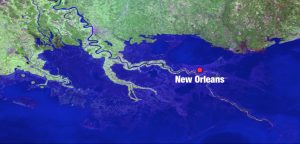What’s At Hand & The Most Recent Catastrophe
 The current and even predicted climate changes within the borders of New Orleans have slowly become a new normal for the city. Whether you believe the changes are due to human interaction or not, the effects have become undeniable. If no action is taken against these detrimental effects, then the city could quite possibly be washed away by 2050. The fourth to make landfall and most recent storm to hit Louisiana, Hurricane Berry, established an entirely new threat to the City of New Orleans. This is not because it contained conditions never seen in previous storms, but because of the preexisting circumstances surrounding the city.
The current and even predicted climate changes within the borders of New Orleans have slowly become a new normal for the city. Whether you believe the changes are due to human interaction or not, the effects have become undeniable. If no action is taken against these detrimental effects, then the city could quite possibly be washed away by 2050. The fourth to make landfall and most recent storm to hit Louisiana, Hurricane Berry, established an entirely new threat to the City of New Orleans. This is not because it contained conditions never seen in previous storms, but because of the preexisting circumstances surrounding the city.
Today Vs. Tomorrow?


Cause & Effect
Increasingly vast amounts of snowmelt within the Great Plains followed by above-normal rainfall has led to an increase in height to the Mississippi River. Following this, at least 70 percent of the coastal salt marshes that protect New Orleans from the impact of storms could easily be emerged by rising sea levels. Let alone, there is still the fact of many portions within the city being eight feet below sea level. All of these factors come into even more extreme accounts once a storm begins to develop near the city simply because it is now nowhere near as tolerable to future storm detriments. Before we dive into what the youth have to offer and have already contributed to these issues, I would like to brief on what has already been implemented.
What’s Currently Being Done To Help?
The largest implication for the city’s coast has been The Coastal Protection and Restoration Authority. This program articulates clear and concise statements of priorities necessary for reconstructing the coast of Louisiana. Up to the present day, CPRA has developed a 2012, 2017, and 2023 coastal master plan along with a yearly annual plan. Each plan carefully produces a new strategy for preserving the coast which includes creating marshes, flood-proofing buildings, restoring shoreline ridges, and more. Looking specifically within the borders of New Orleans; Hydraulic Restoration, Sediment Diversion, and Structural Protection have all been main implications added by the CPRA.
Now that we have a better understanding of what is being done on a larger scale, let’s look a bit deeper as to how much is being done on a small scale.
Community Engagement: All Ages
![]()
This past June within the town of Seventh Ward, New Orleans several children of the community had noticed portions of their elementary playground was flooding. This was then brought up to their parents wondering if there were solutions to the issue at hand. Thus brought forth the creation of a community-driven organization called Healthy Community Services. The organization alleviates flooding as a neighborhood to provide locals the chance to make a small difference in their environmental status and to become apart of something. Not only does this give back to the community but it teaches all ages about bioswales, rain gardens, urban stall water flooding, coastal land loss, sea-level rise, and more.
To learn more about Healthy Community Services visit; https://www.hcsnola.org/
More Must Be Done!
As good as this may sound, it is really the only organization within the city limits of New Orleans working against climate change that has had true involvement with children. Although, it was the children who brought up the idea of the rain garden after learning about them in class. It seems as if the issues of climate change and it’s solutions have been expressed within the classroom, but not much has been offered for them to easily partake in outside of the classroom. About the only other involvement in the fight against it was the meager group of students who had gathered a few blocks from Lusher Middle – High School to protest the urgency to stop climate change. There are too many many young individuals who know of the issues but don’t have the right kind of accessibility to help, there is too much opportunity at hand.
Sources:
https://wattsupwiththat.com/2019/07/12/the-battle-of-new-orleans-climate-change-edition/https://www.markey.senate.gov/GlobalWarming/impactzones/neworleans.htmlhttps://neworleanscitybusiness.com/blog/2019/09/10/louisiana-official-state-adapting-to-new-normal-of-climate-change/https://www.vice.com/en_us/article/bjvb84/new-orleans-has-to-work-fast-to-avoid-washing-away-by-2050https://en.wikipedia.org/wiki/Hurricane_Barry_(2019)https://coastal.la.gov/http://www.pbs.org/wnet/peril-and-promise/2019/06/new-orleans-backyard-flooding-gardens/https://www.desmogblog.com/2019/03/15/new-orleans-student-global-climate-strike-schools
Leave a Reply